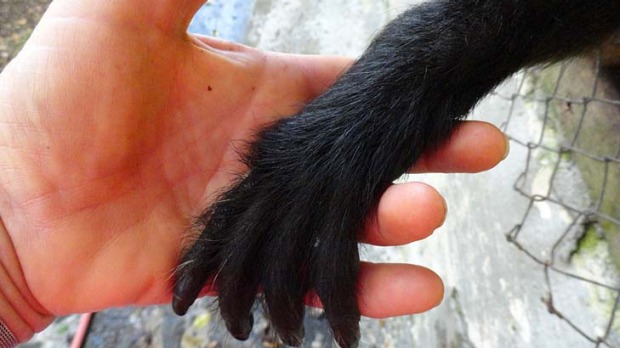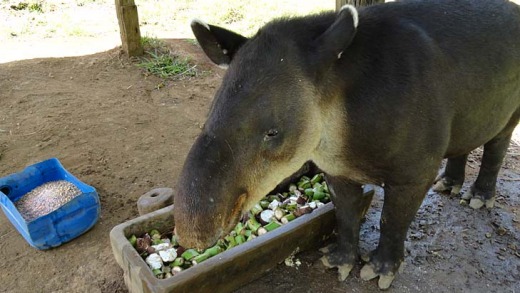
Everyone wants to see the wildlife in Costa Rica. Jane Mundy gets closer than most.
By 8am we're sitting on upturned buckets on the floor of a concrete shed, up to our elbows in bananas, plantains, papayas and a curious tuberous vegetable called yucca. It has very hard, pure white flesh and tough, brown skin and it takes a good whack with a lethally sharp knife to break into bite-size pieces - just the way a hungry tapir likes it.
Later we'll load two big buckets of this concoction into a wheelbarrow and march it down a short track to four hungry tapirs.

Preparing food for the animals is the first task of the day at La Marina, a privately funded animal rescue centre in the central valley of Costa Rica. Animals as diverse as spider monkeys, capuchins, kinkajous, pythons, scarlet macaws, ocelots, eagles and vultures, crocodiles and even a pair of lions find homes here. Some are injured, some have lost their habitats or are handed in by people who have kept them as pets. Some will be nursed back to health and released into their natural habitat - but most will not. They will see out their days at La Marina, cared for and protected.
The small team of volunteers busy chopping, slicing and dicing is like a mini European Union. Tinoos is a thirtysomething Danish opera singer-turned-carpenter. Elias is a Belgian university dropout. Romy is undertaking field work for the biology course she studies in the Netherlands. There is someone from Russia, someone from Germany. They all seem younger than us and must wonder why a couple of oldies from Australia choose to spend a week of their Central American holiday in a place like this.
Yes, we could have opted for something cleaner, safer and more fragrant. But that's one of the things about volunteering - you get all kinds.
As we come along the track with our wheelbarrow, the tapirs - three adults and an adolescent who has just grown out of his stripy juvenile coat - wait and watch. Tapirs are extraordinary-looking creatures, rather like a large pig with an extended nose-cum-trunk. It's as though the animal thought for a while about being an elephant, then changed its mind. They come to the gate of their large, leafy enclosure, hungry and curious, sniffing the air, teeth bared.
I have a healthy respect for wild animals and the need to keep one's distance so I tread cautiously. Two hundred kilograms of angry tapir can make a mess of your arm. Yet although they are equipped with a formidable set of teeth, these tapirs are docile and affectionate - seemingly not just because they're hungry. They appear to be fond of being stroked, scratched and cuddled. Yes, cuddled. Arms around their necks, cheeks pressed against coarse hide. The full love-in.
Around the middle of the day we make our way to the lunch room where volunteers compare the contents of lunch boxes prepared for us by our hosts.
Part of the deal at La Marina is that volunteers are billeted with Costa Rican families and our "mother", Xinia, takes the job of feeding us seriously. Today it is rice and beans. Yesterday it was beans and rice. Xinia speaks barely a word of English but we can more or less make ourselves understood and as well as feeding us and washing our filthy work clothes, Xinia makes us feel part of her wonderful extended family.
It's usual for family members to live next door to one another; living next to Xinia is one of her five sisters and family, and next door again is a brother.
In Costa Rica, where more than 25 per cent of the country is dedicated national park, there's no shortage of animal-viewing opportunities: by river, horse-back ride to the base of a volcano or guided walk through a forest.
Eco-tourism is a big earner but viewing opportunities in the wild, although plentiful, must be from a distance: scarlet macaws flash across a clear blue sky; a sloth is curled high in the tree tops; rustling branches denote a troupe of howler monkeys on the move.
You need luck, patience and good binoculars. At La Marina you get to see animals at close range, for longer, and can touch some of them.
But volunteering here is not all about cuddling tapirs, however. There is hard work to be done and it's not glamorous: bird cages cleaned; building materials carried; paths swept. The wild pigs' enclosure is cleaned daily - not a popular task.
However, there is something satisfying about these hands-on experiences and I find that I don't want to leave. I have become attached to the animals. Even to tapirs.
FAST FACTS
Getting there
United Airlines has a fare to San Jose from Sydney for about $1820 low-season return, including tax. Fly to Los Angeles (13½hr), then to San Jose (about 8hr, including transit time in Houston). Melbourne passengers pay about the same and fly United to Sydney; see united.com. Australians must apply for US travel authorisation before departure; see https://esta.cbp.dhs.gov.
Volunteering there
La Marina Wildlife Rescue Centre is in San Carlos, Alajuela, 60 kilometres north-west of San Jose. A bus ($2.50, about 3hr) operates from downtown San Jose to Ciudad Quesada (8½ kilometres from La Marina).
A flat fee of $US250 ($256) applies regardless of the length of stay, including airport pick-up and introduction to a host family. An extra $US13 a day covers a room and meals; see zoocostarica.com.